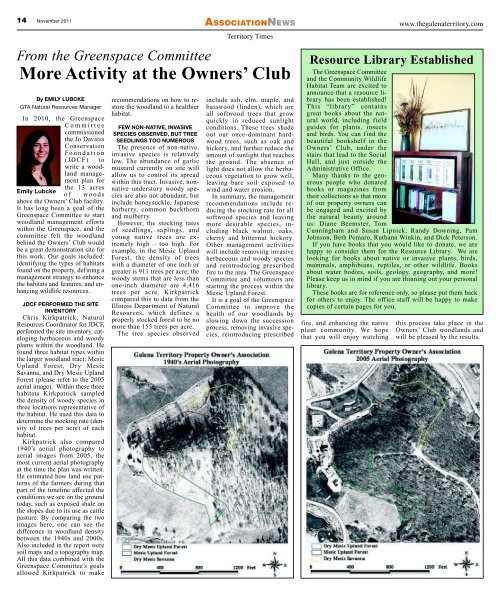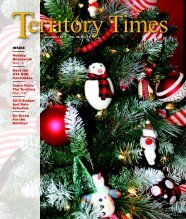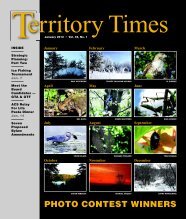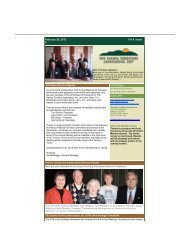November 2011 - The Galena Territory
November 2011 - The Galena Territory
November 2011 - The Galena Territory
Create successful ePaper yourself
Turn your PDF publications into a flip-book with our unique Google optimized e-Paper software.
14 <strong>November</strong> <strong>2011</strong> ASSOCIATIONNEWS<br />
<strong>Territory</strong> Times<br />
From the Greenspace Committee<br />
More Activity at the Owners’ Club<br />
By EMILY LUBCKE<br />
GTA Natural Resources Manager<br />
In 2010, the Greenspace<br />
C o m m i t t e e<br />
commissioned<br />
the Jo Daviess<br />
Conservation<br />
Fo u n d a t i o n<br />
(JDCF) to<br />
write a woodlandmanagement<br />
plan for<br />
Emily Lubcke<br />
the 13 acres<br />
o f wo o d s<br />
above the Owners’ Club facility.<br />
It has long been a goal of the<br />
Greenspace Committee to start<br />
woodland management efforts<br />
within the Greenspace, and the<br />
committee felt the woodland<br />
behind the Owners’ Club would<br />
be a great demonstration site for<br />
this work. Our goals included:<br />
identifying the types of habitats<br />
found on the property, defining a<br />
management strategy to enhance<br />
the habitats and features, and enhancing<br />
wildlife resources.<br />
JDCF PERFORMED THE SITE<br />
INVENTORY<br />
Chris Kirkpatrick, Natural<br />
Resources Coordinator for JDCF,<br />
performed the site inventory, cataloging<br />
herbaceous and woody<br />
plants within the woodland. He<br />
found three habitat types within<br />
the larger woodland tract: Mesic<br />
Upland Forest, Dry Mesic<br />
Savanna, and Dry Mesic Upland<br />
Forest (please refer to the 2005<br />
aerial image). Within these three<br />
habitats Kirkpatrick sampled<br />
the density of woody species in<br />
three locations representative of<br />
the habitat. He used this data to<br />
determine the stocking rate (density<br />
of trees per acre) of each<br />
habitat.<br />
Kirkpatrick also compared<br />
1940’s aerial photography to<br />
aerial images from 2005, the<br />
most current aerial photography<br />
at the time the plan was written.<br />
He estimated how land use patterns<br />
of the farmers during that<br />
part of the timeline affected the<br />
conditions we see on the ground<br />
today, such as exposed shale on<br />
the slopes due to its use as cattle<br />
pasture. By comparing the two<br />
images here, one can see the<br />
difference in woodland density<br />
between the 1940s and 2000s.<br />
Also included in the report were<br />
soil maps and a topography map.<br />
All this data combined with the<br />
Greenspace Committee’s goals<br />
allowed Kirkpatrick to make<br />
recommendations on how to restore<br />
the woodland to a healthier<br />
habitat.<br />
FEW NON-NATIVE, INVASIVE<br />
SPECIES OBSERVED, BUT TREE<br />
SEEDLINGS TOO NUMEROUS<br />
<strong>The</strong> presence of non-native,<br />
invasive species is relatively<br />
low. <strong>The</strong> abundance of garlic<br />
mustard currently on site will<br />
allow us to control its spread<br />
within this tract. Invasive, nonnative<br />
understory woody species<br />
are also not abundant, but<br />
include honeysuckle, Japanese<br />
barberry, common buckthorn<br />
and mulberry.<br />
However, the stocking rates<br />
of seedlings, saplings, and<br />
young native trees are extremely<br />
high – too high. For<br />
example, in the Mesic Upland<br />
Forest, the density of trees<br />
with a diameter of one inch or<br />
greater is 911 trees per acre; the<br />
woody stems that are less than<br />
one-inch diameter are 4,416<br />
trees per acre. Kirkpatrick<br />
compared this to data from the<br />
Illinois Department of Natural<br />
Resources, which defines a<br />
properly stocked forest to be no<br />
more than 155 trees per acre.<br />
<strong>The</strong> tree species observed<br />
include ash, elm, maple, and<br />
basswood (linden), which are<br />
all softwood trees that grow<br />
quickly in reduced sunlight<br />
conditions. <strong>The</strong>se trees shade<br />
out our once-dominant hardwood<br />
trees, such as oak and<br />
hickory, and further reduce the<br />
amount of sunlight that reaches<br />
the ground. <strong>The</strong> absence of<br />
light does not allow the herbaceous<br />
vegetation to grow well,<br />
leaving bare soil exposed to<br />
wind and water erosion.<br />
In summary, the management<br />
recommendations include reducing<br />
the stocking rate for all<br />
softwood species and leaving<br />
more desirable species, including<br />
black walnut, oaks,<br />
cherry and bitternut hickory.<br />
Other management activities<br />
will include removing invasive<br />
herbaceous and woody species<br />
and reintroducing prescribed<br />
fire to the area. <strong>The</strong> Greenspace<br />
Committee and volunteers are<br />
starting the process within the<br />
Mesic Upland Forest.<br />
It is a goal of the Greenspace<br />
Committee to improve the<br />
health of our woodlands by<br />
slowing down the succession<br />
process, removing invasive species,<br />
reintroducing prescribed<br />
fire, and enhancing the native<br />
plant community. We hope<br />
that you will enjoy watching<br />
www.thegalenaterritory.com<br />
Resource Library Established<br />
<strong>The</strong> Greenspace Committee<br />
and the Community Wildlife<br />
Habitat Team are excited to<br />
announce that a resource library<br />
has been established!<br />
This “library” contains<br />
great books about the natural<br />
world, including field<br />
guides for plants, insects<br />
and birds. You can find the<br />
beautiful bookshelf in the<br />
Owners’ Club, under the<br />
stairs that lead to the Social<br />
Hall, and just outside the<br />
Administrative Office.<br />
Many thanks to the generous<br />
people who donated<br />
books or magazines from<br />
their collections so that more<br />
of our property owners can<br />
be engaged and excited by<br />
the natural beauty around<br />
us: Diane Beemster, Tom<br />
Cunningham and Susan Lipnick, Randy Downing, Pam<br />
Johnson, Beth Pomaro, Ruthann Winkin, and Dick Peterson.<br />
If you have books that you would like to donate, we are<br />
happy to consider them for the Resource Library. We are<br />
looking for books about native or invasive plants, birds,<br />
mammals, amphibians, reptiles, or other wildlife. Books<br />
about water bodies, soils, geology, geography, and more!<br />
Please keep us in mind if you are thinning out your personal<br />
library.<br />
<strong>The</strong>se books are for reference only, so please put them back<br />
for others to enjoy. <strong>The</strong> office staff will be happy to make<br />
copies of certain pages for you.<br />
this process take place in the<br />
Owners’ Club woodlands and<br />
will be pleased by the results.







